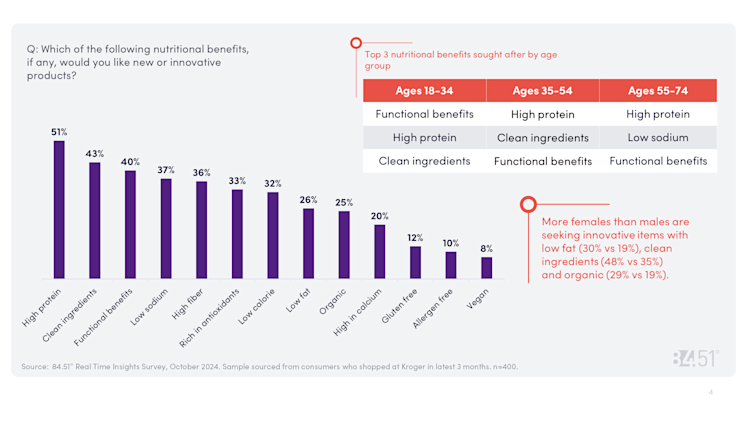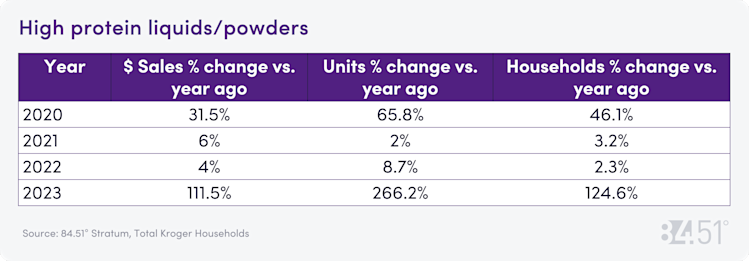
Nourishing trends: Protein-rich and easy meal prep on the rise

Note: Article updated 12/10/24
As shoppers browse store aisles or retailer apps, two trends are emerging: a demand for protein-rich products and more solutions for preparing healthy, convenient meals at home. These trends offer brands and retailers opportunities to cater to shoppers who prioritize health and convenience in their meal choices as part of a broader shift towards holistic health.
1. Protein-rich products
Shoppers across different age groups from Generation Z and millennials to Generation X and baby boomers indicated that they are seeking high protein as a nutritional benefit in products (see chart below).
Health journals and publications, including Harvard Health and MDPI Journal, report that high protein intake supports muscle maintenance and growth, which is particularly important for older consumers to prevent muscle loss and maintain mobility. For younger consumers, protein is essential for energy, recovery and overall physical performance.
Additionally, the Wall Street Journal notes that consumers taking GLP-1 drugs are consuming more fresh fruits and vegetables and, in particular, seeking out increased protein and fiber to help with muscle maintenance and digestive issues. Morgan Stanley estimates that the global market for appetite suppressing weight-loss drugs could increase by more than 15-fold by 2030 as their use expands beyond weight loss to treat a range of diseases.
All of these factors point to increased demand for convenient, protein-rich products. Indeed, an analysis of high protein liquids and powders sold at Kroger stores revealed notable percentage increases in dollar sales, units and households, especially in 2023.
2. Healthy and convenient meal solutions
Another growing trend is a demand for meal solutions that are both healthy and easy to prepare. Our research shows that consumers want to have more planned meals at home and that they associate home-cooked meals with healthy eating. However, consumers are increasingly short on time and they are seeking innovative solutions for healthy and convenient meals.
For instance, 63% of shoppers expressed a desire for new items or innovations in frozen foods, making it the leading grocery category where shoppers are seeking innovation, according to our survey.
Shoppers are also showing interest in value-added produce, such as pre-cut and pre-washed fruits, which cater to shoppers looking for time-saving solutions. Of Kroger households that purchase value-added fruit, 99.5% also purchase regular fruit (source 84.51° Stratum). This could indicate that shoppers see value-added fruit as an enhancement to their regular fruit purchases—using them to save time—and the high overlap suggests that value-added options are becoming part of their shopping habits.
These two trends—demand for protein-rich products and solutions for healthy, convenient meals—should not be considered in isolation. Instead, they are part of a broader shift towards holistic health. Consumers are increasingly looking for ways to integrate health and wellness into all aspects of their lives, from the nutritional content of their food to the convenience of meal preparation. This holistic approach reflects a growing awareness that health is multifaceted, encompassing not just diet but also lifestyle and overall well-being. Brands and retailers that recognize and respond to this comprehensive view of health will be better positioned to meet the evolving needs of their customers.
Visit our knowledge hub
See what you can learn from our latest posts.


![[DO NOT DELETE] 8451-PR header 4000x2000 shutterstock 2146084959 po](https://images.ctfassets.net/c23k8ps4z1xm/CUmZcselsJUhnLz6rQuj2/0e48394e72423bb1073bf8bb6cf75974/8451-PR_header_4000x2000_shutterstock_2146084959_po.jpg?w=328&h=232&fit=fill)